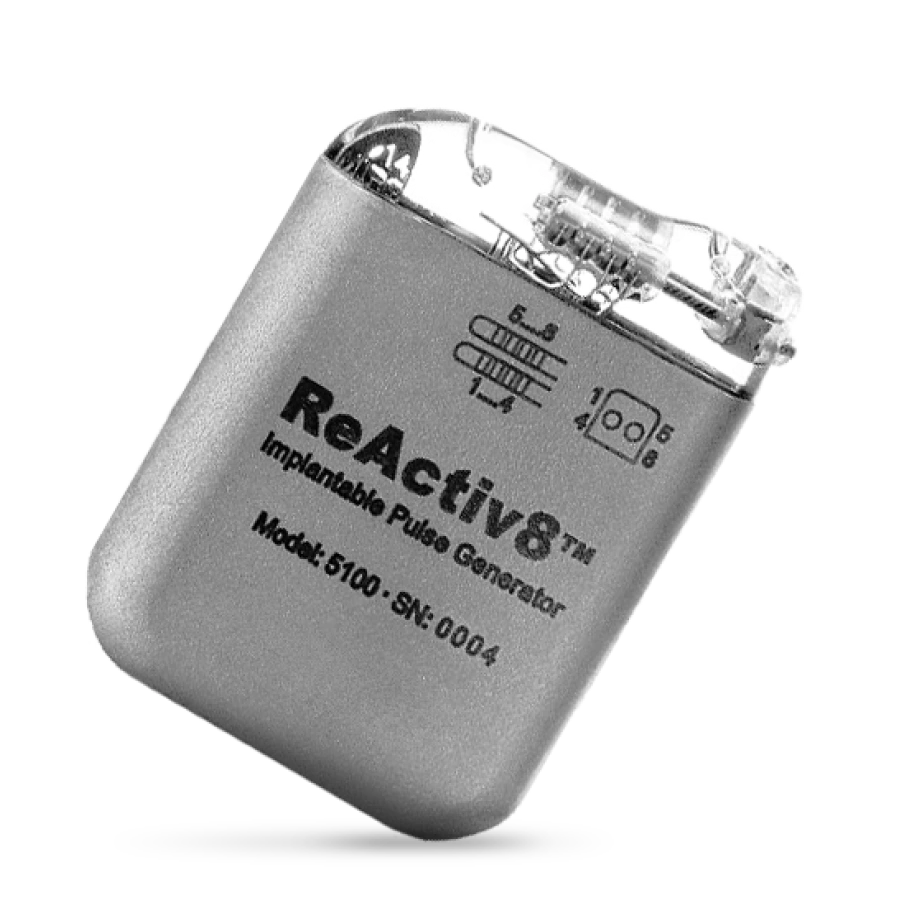ReActiv8
Safety & Product
Information

Australia Rx Only
ALWAYS READ THE INSTRUCTIONS FOR USE. Refer to user manual for a complete listing of indications, warnings, precautions, potential adverse events, and directions for use. If symptoms persist, worsen or change unexpectedly, talk to your health professional.
Intended Purpose/Indications for Use: The ReActiv8 System is indicated as an aid in the management of intractable chronic low back pain associated with multifidus muscle dysfunction, as evidenced by imaging or physiological testing.
Warnings
- It is very important that you inform your physician or other healthcare professional (e.g. physical therapist, chiropractor, dentist, etc.) that you are implanted with the ReActiv8.
- Magnetic Resonance Imaging (MRI) – You SHOULD NOT have an MRI scan, as it may be hazardous for you.
- Diathermy – You SHOULD NOT receive diathermy therapy, as it may be hazardous for you.
- Strangulation by cable – When operating the Activator, keep the antenna cable away from your neck to avoid strangulation. Do not allow children to handle or play with the Activator.
- Case damage – If the case that the Activator is pierced or ruptured, burns could result from exposure to battery chemicals.
Adverse Event Summary
The implantation of ReActiv8 involves risks similar to those of peripheral nerve stimulators. In addition to risks commonly associated with surgery, implantation or use of ReActiv8 includes, but is not limited to, the following risks:
- Adverse Events (AEs) associated with the surgical procedure, including implant, revision, replacement and removal
- Acute or persistent pain including more pain than anticipated after surgery or worsened low back pain
- Accidental injury to adjacent tissues, e.g. piercing structures such as muscle, blood vessels or organs
- Infection, including local infection of the surgical site, systemic infection and sepsis
- Slow, abnormal or inadequate wound healing including wound dehiscence (slow healing), which may require surgical repair
- Tissue reaction to the presence of the implanted device or materials in/on the implanted device such as response to residual material on device or an allergic response, e.g. previously unknown nickel or titanium allergy. Reaction may be local or systemic.
- Nerve irritation, impingement or damage, including that resulting from mechanical presence of device, exposure to electricity including electrical stimulation, or migration of the leads, suture sleeve or IPG. This may lead to pain, paralysis, sensory deficits or changes to bowel, bladder or reproductive function.
- Undesired sensations such as uncomfortable paraesthesia, numbness, vibration, pressure, prickling, or uncomfortable contraction of the multifidus
- Overstimulation of tissue, resulting in symptoms such as painful muscle contraction, paraesthesia, jolts or shocks. In addition, injuries that occur as a consequence of stimulation, e.g. accidents that occur as a result of being startled.
- Tissue damage due to mechanical presence of device, or exposure to electricity including electrical stimulation.
- Contraction of muscles other than the target muscle(s)
- Muscle fatigue, spasm or injury
- Stiffness, including restricted motion due to adhesions to the device
- Inability to deliver stimulation, including inadequate doses of stimulation. Causes include lead migration, device malfunction or exposure to electromagnetic fields, e.g. security screening devices
- Undesired electrical stimulation
- Inability to stop therapy, with possible sequelae such as anxiety, restriction of movement, pain, muscle fatigue, postural changes, difficulty in walking, sitting or physical activity
- Accidents, injuries, body movements, body positions or biological processes which lead to device complications. Examples include a fall which may cause damage to the IPG; sit-ups or severe coughing leading to migration of the lead; or fracture of bones leading to device migration or damage
- Device extrusion
- Erosion, threatened erosion or fistula formation in skin overlying device components
- Excessive fibrotic tissue growth
- Hematoma, seroma, cyst or swelling
- Acute or persistent pain including worsened low back pain and/or pain and discomfort due to presence of the device
You may also undergo medical and/or surgical intervention (such as revision or explant) to treat the issues identified above.